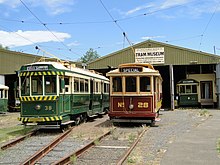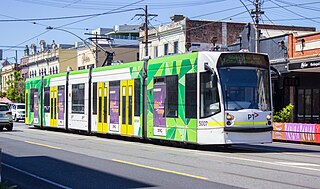
Melbourne tram route 6 is operated by Yarra Trams on the Melbourne tram network from Moreland to Glen Iris. The 19.2-kilometre (11.9 mi) route is operated out of Brunswick and Malvern depots with Z, B and D class trams.
The Tramway Museum Society of Victoria Incorporated (TMSV) owns a large collection of trams from Melbourne, Ballarat, Geelong, Adelaide, and Sydney as well as preserved buses and other work vehicles.

The W-class trams are a family of electric trams built by the Melbourne & Metropolitan Tramways Board (MMTB) between 1923 and 1956. Over the 33 years of production, 752 vehicles spanning 12 sub-classes were constructed, the majority at the MMTB's Preston Workshops.
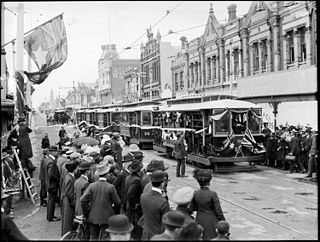
The Prahran and Malvern Tramways Trust (PMTT) was a former tram operator in Melbourne, Australia. The trust was formed in 1907, with its first line operating in 1910. Its functions were taken over by the Melbourne & Metropolitan Tramways Board in 1920.

The earliest trams in Australia operated in the latter decades of the 19th century, hauled by horses or "steam tram motors". At the turn of the 20th century, propulsion almost universally turned to electrification, although cable trams lingered in Melbourne. In cities and towns that had trams, they were a major part of public transport assets.

Trams in Ballarat were first used for public transport in 1887. They ceased to operate as a means of public transport in 1971, but a section continues to be operated today as a tourist attraction.

The city of Geelong in Victoria, Australia, operated an extensive tramway system from 1912 until 1956, when the service was replaced by buses. Unlike Victoria's other major regional cities, Ballarat and Bendigo, which have kept some track and trams as tourist attractions, no trams or tracks remain in Geelong.
Melbourne's tram classification system is based on classes originally devised by the Melbourne & Metropolitan Tramways Board (M&MTB). At first this was largely based on the order in which the original tramway operators had introduced each different type of tramcar between 1906 and 1920.

The C-class was a group of 11 trams built by Duncan & Fraser, Adelaide for the Prahran & Malvern Tramways Trust (P&MTT) in 1913, numbered 25 to 35. All retained their fleet numbers when passed to the Melbourne & Metropolitan Tramways Board (M&MTB) on 2 February 1920, after it took over the P&MTT. They were designated C-class sometime after October 1921, and by late 1923, all M&MTB drop-end-and-centre Maximum Traction trams were grouped together as C-class trams. The 22E Maximum Traction trucks were of JG Brill design, although manufactured by Brush in England.

The E-class was a group of 10 trams built by Duncan & Fraser, Adelaide, for the Prahran & Malvern Tramways Trust (P&MTT) in 1914, numbered 36 to 45. Number 36 was converted to a different form by the P&MTT c. 1916, and was later designated D-class. All retained their fleet numbers when passed to the Melbourne & Metropolitan Tramways Board (M&MTB) after it took over the P&MTT on 2 February 1920, and they were designated E-class sometime after October 1921. By late 1923, together with other all M&MTB drop-end-and-centre Maximum Traction trams, they were re-classed as C-class trams. The 22E Maximum Traction trucks were of JG Brill design, although manufactured by Brush in England.

The H-class was a class of ten trams built by Duncan & Fraser, Adelaide for the Prahran & Malvern Tramways Trust (PMTT). All passed to the Melbourne & Metropolitan Tramways Board on 2 February 1920 when it took over the PMTT becoming the H-class retaining their running numbers. In 1931, number 63 was sold for further use on the Ballarat network and placed in service as number 18.
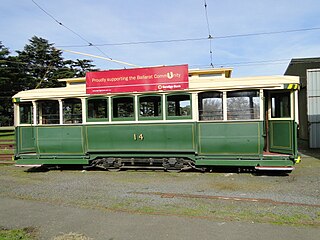
The J-class was a class of twenty trams built by the Meadowbank Manufacturing Company, Sydney for the Prahran & Malvern Tramways Trust (PMTT). All passed to the Melbourne & Metropolitan Tramways Board on 2 February 1920 when it took over the PMTT becoming the J-class retaining their running numbers.
The L-class was a class of six trams ordered from James Moore & Sons by the Prahran & Malvern Tramways Trust (PMTT). However, by the time they were delivered in 1921, the PMTT had been taken over by the Melbourne & Metropolitan Tramways Board (MMTB).
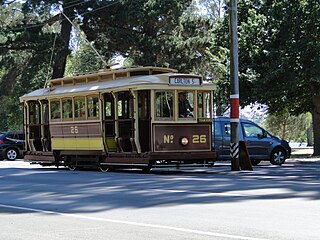
The M-class was a class of 17 trams built by Duncan & Fraser, Adelaide for the Hawthorn Tramways Trust (HTT) as numbers 1 to 10, and 33 to 39. All passed to the Melbourne & Metropolitan Tramways Board on 2 February 1920 when it took over the Municipal Tramway Trusts, becoming the M-class and being renumbered 107 to 116, and 183 to 189.
The N-class was a class of 10 trams built by Duncan & Fraser, Adelaide for the Hawthorn Tramways Trust (HTT) as numbers 11 to 20, all passed to the Melbourne & Metropolitan Tramways Board (M&MTB) on 2 February 1920 when it took over the HTT, becoming the N-class and being renumbered 117 to 126.
The O-class Melbourne tram were a group of four trams built in 1912 by Duncan & Fraser (Adelaide) for the Prahran & Malvern Tramways Trust (P&MTT) upon the recommendation of W. G. T. Goodman, Chief Engineer and General manager of the Adelaide tramways. They were allocated P&MTT fleet numbers 21 to 24. At the time of their introduction, they were by far the largest street-vehicles in Melbourne, and earned the nicknames Zeppelins and Dreadnoughts. Proving to be less than satisfactory in service, they were later sold to the Hawthorn Tramways Trust (HTT) in August 1916 as "surplus to requirements", however P&MTT soon ordered replacement tramcars. Coincidentally they retained their fleet numbers whilst at Hawthorn.

The P-class was a class of eight trams built by Duncan & Fraser, Adelaide for the Hawthorn Tramway Trust (HTT) as numbers 25 to 32. All passed to the Melbourne & Metropolitan Tramways Board on 2 February 1920 when it took over the HTT becoming the P-class and being renumbered 131 to 138.
The S-class was a class of 18 trams built by Duncan & Fraser, Adelaide for the Melbourne, Brunswick & Coburg Tramways Trust (MBCTT). The first 12 entered service in 1916, numbered 1 to 12. All passed to the Melbourne & Metropolitan Tramways Board (MMTB) on 2 February 1920 when it took over the MBCTT, becoming the S-class and renumbered 154-165.
The Adelaide D type tram was a class of trams operated by the Municipal Tramways Trust on the Adelaide tram network from 1910 until 1958.
The Melbourne tram network began in 1884 with the construction of the Fairfield Horse Tramway. However, the purpose of the line was to increase land prices in the area, and it soon closed during the depression in 1890. The first genuine attempt to construct a tramway network was the construction of the Richmond cable tram line by the Melbourne Tramway & Omnibus Company in 1885. Over the next few years, 16 more cable tram lines were constructed, as well as numerous other horse tramways. The depression of the early 1890s slowed further expansion of the cable network. The first electric tram line was the Box Hill and Doncaster tramway which opened in 1889. This was a pioneering line in what was then the countryside and thus didn't receive much patronage. It closed in 1896. The next attempt at an electric tramway was Victorian Railways' St Kilda to Brighton line, which opened in 1906. Later that year, the North Melbourne Electric Tramway & Lighting Company opened lines to Essendon and Maribyrnong. Many local councils formed their own tramway trusts and built tramways within their own constituency. The most successful of these was the Prahran & Malvern Tramways Trust.







